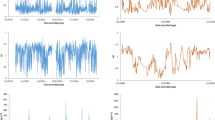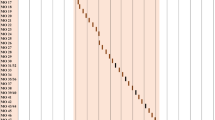Abstract
Nowadays, high-time resolved aerosol studies are mandatory to better understand atmospheric processes, such as formation, removal, transport, deposition or chemical reactions. This work focuses on PM10 physical and chemical characterisation with high-time resolution: elements (from Na to Pb), ions and OC/EC fractions concentration were determined during two weeks in summer and two in winter 2006 with 4-hours resolution. Further measurements aimed at hourly elemental characterisation of fine and coarse fractions and at the determination of particles number concentration in the 0.25–32 μm size range in 31 bins. The chemical mass closure was carried out in both seasons, enhancing intra-day differences in PM10 composition. In Milan, the highest contribution came from organic matter (34% and 33% in summer and winter, respectively); other important contributors were secondary inorganic compounds (16% and 24% in summer and winter, respectively) and, in summer, crustal matter (14%). Temporal trends showed strong variations in PM10 composition during contiguous time-slots and diurnal variations in different components contribution were identified. Moreover, peculiar phenomena, which would have hardly been detected with 24-hours samplings, were evidenced. Particles removal due to precipitations, aerosol local production and long range transport were studied in detail.
Similar content being viewed by others
References
Alastuey, A., Querol, X., Rodrìguez, S., Plana, F., Lopez-Soler, A., Ruiz, C. et al. (2004). Monitoring of atmospheric particulate matter around sources of secondary inorganic aerosol. Atmospheric Environment, 38, 4979–4992.
Andrews, E., Saxena, P., Musarra, S., Hildemann, L. M., Koutrakis, P., McMurry, P. H. et al. (2000). Concentration and composition of atmospheric aerosol from the 1995 SEAVS experiment and a review of the closure between chemical and gravimetric measurement. Journal of the Air and Waste Management Association, 50, 648–664.
Artaxo, P., Oyola, P., & Martinez, R. (1999). Aerosol composition and source apportionment in Santiago de Chile. Nuclear Instruments and Methods in Physics Research Section B Beam Interactions with Materials and Atoms, 150, 409–416.
Artìñano, B., Querol, X., Salvador, P., Rodrìguez, S., Alonso, D. G., & Alastuey, A. (2001). Assessment of airborne particulate levels in Spain in relation to the new EU-directive. Atmospheric Environment, 35(suppl.1), S43–S53.
Begum, B. A., Hopke, P. K., & Zhao, W. (2005). Source identification of fine particles in Washington D.C., by expanded factor analysis modeling. Environmental Science and Technology, 39, 1129–1137.
Birch, M. E., & Cary, R. A. (1996). Elemental carbon-based method for monitoring occupational exposures to particulate diesel exhaust. Aerosol Science and Technology, 25, 221–241.
Calzolai, G., Chiari, M., García Orellana, I., Lucarelli, F., Migliori, A., Nava, S., et al. (2006). The new external beam facility for environmental studies at the Tandetron accelerator of LABEC. Nuclear Instruments and Methods in Physics Research Section B Beam Interactions with Materials and Atoms, 249(1–2), 928–931.
Chate, D. M. (2005). Study of scavenging of submicron-sized aerosol particles by thunderstorm rain events. Atmospheric Environment, 39, 6608–6619.
Chow, J. C., & Watson, J. G. (2002). PM2.5 carbonate concentration at regionally representative interagency monitoring of protected visual environment sites. Journal of Geophysical Research, 107, D21: 8344. doi:10.1029/2001JD000574.
D’Alessandro, A., Lucarelli, F., Mandò, P. A., Marcazzan, G., Nava, S., Prati, P. et al. (2003). Hourly elemental composition and sources identifcation of fine and coarse PM10 particulate matter in four Italian towns. Aerosol Science, 34, 243–259.
Draxler, R. R., & Rolph, G. D. (2003). HYSPLIT (HYbrid Single-Particle Lagrangian Integrated Trajectory), NOAA Air Resources Laboratory, Silver Spring, MD. Model access via NOAA ARL READY Website http://www.arl.noaa.gov/ready/hysplit4.html.
Fermo, P., Piazzalunga, A., Vecchi, R., & Valli, (2006). G. Set-up of extraction procedures for ions quantification in aerosol samples. Chemical Engineering Transactions, 10, 203–208.
Giugliano, M., Lonati, G., Butelli, P., Romele, L., Tardivo, R., & Grosso, M. (2005). Fine particulate (PM2.5–PM1) at urban sites with different traffic exposures. Atmospheric Environment, 39, 2421–2431.
Graney, J. R., Dvonch, J. T., & Keeler, G. J. (2004). Use of multi-element tracers to source apportion mercury in south Florida aerosol. Atmospheric Environment, 38, 1725–1726.
Greenfield, S. (1957). Rain scavenging of radioactive particulate matter from the atmosphere. Journal of Meteorology, 14, 115–125.
Hoek, G., Meliefste, K., Cyrys, J., Lewné, M., Bellander, T., Brauer, M. et al. (2002). Spatial variability of fine particle concentrations in three European areas. Atmospheric Environment, 25, 4077–4088.
Hueglin, C., Gehrig, R., Baltensperger, U., Gysel, M., Monn, C., & Vonmont, H. (2005). Chemical characterization of PM2.5, PM10 and coarse particle at urban, near-city and rural sites in Switzerland. Atmospheric Environment, 39, 637–651.
Jang, M., Lee, S., & Kamens, R. M. (2003). Organic aerosol growth by acid-catalyzed heterogeneous reactions of octanal in a flow reactor. Atmospheric Environment, 37, 2125–2138.
Kim, E., & Hopke, P. K. (2006). Characterization of fine particle sources in the great smoky mountains area. The Science of the Total Environment, 368, 781–794.
Maenhaut, W., & Cafmeyer, J. (1998). Long-term atmospheric aerosol study at urban and rural sites in Belgium using multi-elemental analysis by particle-induced x-ray emission spectrometry and short-irradiation instrumental neutron activation analysis. X-ray Spectrometry, 27, 236–246.
Maenhaut, W., Schwarz, J., Cafmeyer, J., & Chi, X. (2002). Aerosol chemical mass closure during the EUROTRAC-2 AEROSOL Intercomparison 2000. Nuclear Instruments and Methods in Physics Research Section B Beam Interactions with Materials and Atoms, 189, 233–237.
Marcazzan, G. M., Caprioli, E., Valli, G., & Vecchi, R. (2003a). Temporal variation of 212Pb concentration in outdoor air of Milan and a comparison with 214Bi. Journal of Environmental Radioactivity, 65, 77–90.
Marcazzan, G. M., Ceriani, M., Valli, G., & Vecchi, R. (2003b). Source apportionment of PM10 and PM2.5 in Milan (Italy) using receptor modelling. The Science of the Total Environment, 317, 137–147.
Marcazzan, G. M., Ceriani, M., Valli, G., & Vecchi, R. (2004). Composition, components and sources of fine aerosol fractions using multielemental EDXRF analysis. X-Ray Spectrometry, 33, 267–272.
Marcazzan, G. M., Vaccaro, S., Valli, G., & Vecchi, R. (2001). Characterisation of PM10 and PM2.5 particulate matter in the ambient air of Milan (Italy). Atmospheric Environment, 35, 4639–4650.
Mason, B. (1966). Principles of geochemistry. New York: Wiley and Sons.
Mazzei, F., Lucarelli, F., Nava, S., Prati, P., Valli, G., & Vecchi, R. (2007). A new methodological approach: the combined use of two-stage streaker samplers and optical particle counters for the characterization of airborne particulate matter. Atmospheric Environment, 41, 5525–5535.
McMurry, P. H. (2000). A review of atmospheric aerosol measurement. Atmospheric Environment, 43, 1959–1999.
Nassetti, S. (1996). Andamento giornaliero della concentrazione di inquinanti aerodispersi: il giorno rappresentativo. Degree Thesis in Physics, University of Bologna, Italy (in Italian).
Pacifico, F. (2005). Il Radon come tracciante dell’altezza dello strato rimescolato: sviluppo di un modello a box. Degree Thesis in Physics, University of Milan, Italy (in Italian).
Prati, P., Zucchiatti, A., Tonus, S., Lucarelli, F., Mandò, P. A., & Ariola, V. (1998). A testing technique of streaker aerosol samplers via PIXE analysis. Nuclear Instruments and Methods in Physics Research Section B Beam Interactions With Materials and Atoms, 136–138, 986–989.
Putaud, J. P., Raes, F., Van Dingenen, R., Brüggenmann, E., Facchini, M. C., Decesari, S. et al. (2004). A European aerosol phenomenology-2: chemical characteristics of particulate matter at kerbside, urban, rural and background sites in Europe. Atmospheric Environment, 38, 2579–2595.
Puxbaum, H., & Tenze-Kunit, M. (2003). Size distribution and seasonal variation of atmospheric cellulose. Atmospheric Environment, 37, 3693–3699.
Qin, Y., & Oduyemi, K. (2003). Atmospheric aerosol source identification and estimates of source contributions to air pollution in Dundee, UK. Atmospheric Environment, 37, 1799–1809.
Querol, X., Alastuey, A., Puicercus, J. A., Mantilla, E., Ruiz, C. R., Lopez-Soler, A. et al. (1998). Seasonal evolution of suspended particles around a large coal-fired power station: chemical characterization. Atmospheric Environment, 32, 719–731.
Querol, X., Alastuey, A., Ruiz, C. R., Artiñano, B., Hansson, H. C., Harrison, R. M. et al. (2004). Speciation and origin of PM10 and PM2.5 in selected European cities. Atmospheric Environment, 38, 6547–6555.
Raes, F., Van Dingenen, R., Vignati, E., Wilson, J., Putaud, J. P., Seinfeld, J. H. et al. (2000). Formation and cycling of aerosols in the global troposphere. Atmospheric Environment, 34, 4215–4240.
Rolph, G. D. (2003). Real-time Environmental Appli cations and Display System (READY) Website (http://www.arl.noaa.gov/ready/hysplit4.html). NOAA Air Resources Laboratory, Silver Spring, MD.
Seinfeld, J. H., & Pandis, S. N. (1998). Atmospheric chemistry and physics. New York: John Wiley.
Song, X. H., Polissar, A. V., & Hopke, P. K. (2001). Sources of fine particle composition in the northeastern US. Atmospheric Environment, 35, 5277–5286.
Thomaidis, N. S., Bakeas, E. B., & Siskos, P. A. (2003). Characterization of lead, cadmium, arsenic and nickel in PM2.5 particles in the Athens atmosphere, Greece. Chemosphere, 52, 959–966.
Turpin, B. J., & Huntzicker, J. J. (1995). Identification of SOA episodes and quantification of primary and secondary organic aerosol concentrations during SCAQS. Atmospheric Environment, 29, 3527–3544.
Turpin, B. J., & Lim, H. J. (2001). Species contributions to PM2.5 mass concentration: revisiting common assumption for estimating organic mass. Aerosol Science and Technology, 35, 602–610.
Vecchi, R., Marcazzan, G., Valli, G., Ceriani, M., & Antoniazzi, C. (2004). The role of atmospheric dispersion in the seasonal variation of PM1 and PM2.5 concentration and composition in the urban area of Milan (Italy). Atmospheric Environment, 38, 4437–4446.
Vecchi, R., Marcazzan, G., Valli, G., Ceriani, M., & Antoniazzi, C. (2007). A study on nighttime–daytime PM10 concentration and elemental composition in relation to atmospheric dispersion in the urban area of Milan (Italy). Atmospheric Environment, 41, 2136–2144.
Author information
Authors and Affiliations
Corresponding author
Rights and permissions
About this article
Cite this article
Vecchi, R., Bernardoni, V., Fermo, P. et al. 4-hours resolution data to study PM10 in a “hot spot” area in Europe. Environ Monit Assess 154, 283–300 (2009). https://doi.org/10.1007/s10661-008-0396-1
Received:
Accepted:
Published:
Issue Date:
DOI: https://doi.org/10.1007/s10661-008-0396-1




